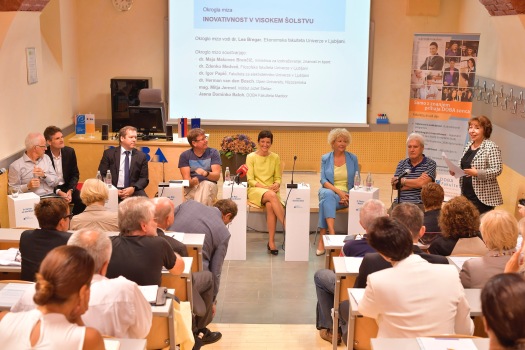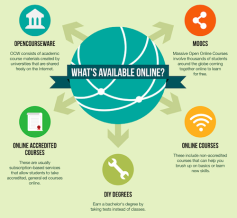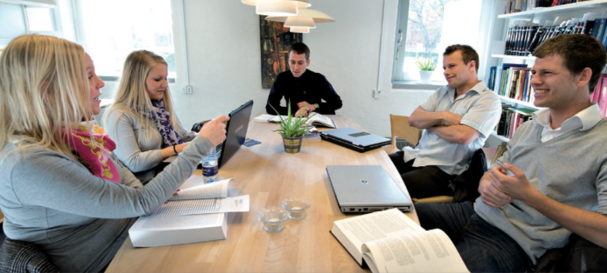Changes in higher education in the US are worth looking at, because they will turn up worldwide in due course [1]. Higher education in the US is ready for disruption[2]: During the past 30 years, fees have increased 538%, which is 4 1/2 times more than average. Until recently, the earnings of alumni allowed them to repay their loans. The past five years saw a dramatic change in their prospects. As a consequence, debt has quadrupled in 10 years to $1,1 trillion now.
At the same time, employers complain about alumni’s lack of skills. According to Gallup[3] 95% agreed with the statement Graduates are woefully underprepared. 40% of all vacant jobs cannot be realized.
 The number of students who combine study and work is almost 50%. These students prefer programs that are beneficial for their careers and utilize their work experience. They do not fall for the charms of campus life but feel attracted by the flexibility of distance learning.
The number of students who combine study and work is almost 50%. These students prefer programs that are beneficial for their careers and utilize their work experience. They do not fall for the charms of campus life but feel attracted by the flexibility of distance learning.
The problems mentioned above are not new. However, higher education institutions, fearing disruptive innovators, seem more willingly than ever to act.
Higher education policy has always cherished three aims: affordability, accessibility and quality but failed in realizing these aims simultaneously. Exactly this happens right now. Educause, together with Next Generation Learning Challenges launched a call inviting institutions to co-develop bachelor and master programs with fees that do not exceed $5000 a year[4]. Many institutions hurried to redesign their educational offerings, the most prestigious universities of the US among them.
Solutions for the problems and challenges mentioned so far come from four different directions: competency-based learning, flexibility, e-learning and specialization.
Competency-based learning
One of the first institutions that offered competency-based learning in the US is the Western Governors University (WGU) [5]. Its courses of study are based on specified competences and they are preceded by a pre-assessment. This is screening students’ deficiencies resulting in a dedicated offering of materials[6].
 Improving the alignment between education and labour market has many other implications. In their book ‘A New culture of learning’ Douglas Thomas and John Seeley Brown introduce entrepreneurial students. They assemble their own curriculum by taking courses from several universities. In addition, they opt for intensive skill trainings like DevBootcamp, Hackbright en General Assembly[7]. The Apollo Education group has developed the program ‘Balloon’ for this kind of students. It offers 15.000 courses, grouped by learning objectives, level, price and type of education. Many universities facilitate this explorative behavior of students and a variety of experiments are set in place[8].
Improving the alignment between education and labour market has many other implications. In their book ‘A New culture of learning’ Douglas Thomas and John Seeley Brown introduce entrepreneurial students. They assemble their own curriculum by taking courses from several universities. In addition, they opt for intensive skill trainings like DevBootcamp, Hackbright en General Assembly[7]. The Apollo Education group has developed the program ‘Balloon’ for this kind of students. It offers 15.000 courses, grouped by learning objectives, level, price and type of education. Many universities facilitate this explorative behavior of students and a variety of experiments are set in place[8].
Organizations like Degreed and the Mozilla Open Badge Platform are able to validate students’ extra-curricular activities. They map students’ competences and also how these competences relate to existing grades and diplomas[9].
One of the most fascinating ideas is Stanford’s imaginary Open Loop University. It will enable students to interrupt their program of study with two years of extra-curricular activities that have potential relevance for the core-curriculum, like work, externships, voluntary activities and studying abroad[10].
 Competency-based learning, combined with personalization will dismiss the notion of fixed seat-time. This is weighting the workload of a course by the number of class hours. It will even go beyond the system of credit-points that express nominal study load. What counts is the mastery of competencies irrespective of time and effort to realize these.
Competency-based learning, combined with personalization will dismiss the notion of fixed seat-time. This is weighting the workload of a course by the number of class hours. It will even go beyond the system of credit-points that express nominal study load. What counts is the mastery of competencies irrespective of time and effort to realize these.
Flexibility
Flexibility is connected with competency-based learning. Focussing on mastery of specific competencies, students are free in the choice of course materials. Tutors or consultants are available to help them selecting the most appropriate ones[11].
 The Western Governors University allows student to start a course of studies nearly each day of the year and to take as much time as they need. Students pay $6000 per year, an amount of money that allows them taking as many courses of study as they want.
The Western Governors University allows student to start a course of studies nearly each day of the year and to take as much time as they need. Students pay $6000 per year, an amount of money that allows them taking as many courses of study as they want.
e-Learning
e-Learning is seamlessly connected with competency-based learning, and is enabling flexibility and affordability at once. In fact we envisage a second e-learning revolution. The beginning of the 21th century gave birth to the first Internet universities. Though, their programmes were technology-pushed, their supervision was unsatisfactory, they were too expensive and above all, their status was low. Now 15 years later the landscape has changed dramatically.
The initiative came from the well-established universities, like MIT, Harvard and Stanford. They started with Open Educational Resources, useful for teachers in the first place. Then MOOCs showed-up, valuable learning materials, though without credits. But change is ahead. MOOCs become integrated in regular education of both high-end and low-end educational institutions. Most of the first mentioned ones opt for blended-learning. For instance, Harvard is considering one year online learning, resulting in the selection of an elite group of students who will be on campus for two years, followed by a combination of work and study[12].
 MIT believes ‘modularization’ will be the solution and plans to disaggregate courses in small packages, which can be combined. MOOCs provided by EdX will help students acquire the basics. In addition, they visit learning villages. Here practicals and other group activities take place[13]. The same applies to Duke University, in cooperation with Coursera.
MIT believes ‘modularization’ will be the solution and plans to disaggregate courses in small packages, which can be combined. MOOCs provided by EdX will help students acquire the basics. In addition, they visit learning villages. Here practicals and other group activities take place[13]. The same applies to Duke University, in cooperation with Coursera.
The prestigious Georgia Tech University is moving into another direction in cooperation with Udacy, another supplier of MOOCs[14]. Together they offer a $7000 master program in Information science that results in the same grade as its $40.000 equivalent on the campus. The university feels that the difference in target groups will prevent cannibalization of the expensive programme by the cheap one. The free courses of Udacy are available too but without additional assignments and credits.
Specialization
Specialization is another strategy to survive. Institutions like WGU are able to offer an affordable programme because they renounce the development of learning materials of its own.
Learning materials like MOOCs are developed by well-known universities and distributed by companies like Udacy, Edx and Coursera. Publishers, like Pearson are developing and delivering e-learning programs too. Google plans with MOOCs.org to become the YouTube for MOOCs.
Many universities in general and community colleges in particular will survive as campus universities only if they deprioritize research and cease competing with Harvard or other high-end institutions. Their niche is training for the local or regional labour market in tight collaboration with local or regional companies.
Lastly, institutions like the Pacific Gas & Electric Power Pathways and the Clemson University International Centre for Automotive Research opt for topical specialization in order to educate dedicated labour force.
The higher education landscape will change fast. Students will build unique portfolio’s combining a diversity of resources. Specialized institutions will validate their competences and probably even reward them. Sometimes, these grades will match with existing programs However, the most distinguishing students will prefer unique profiles that might not be academically recognized but that will be priceless for employers. Guess who is better off!
[1] Comprehensive essay about the development of higher education in the US. It inspired me to write this blogpost. http://dupress.com/articles/reimagining-higher-education/?id=us:2sm:3tw:dup758:eng:fed:111914:du_press:sxswedu
[2] See the publications of Clayton Christensen and colleagues. After ‘The innovator’s dilemma'(1997) and ‘Disrupting College: How Disruptive Innovation Can Deliver Quality and Affordability to Postsecondary'(2011) http://goo.gl/ogr5r is ‘Hire Education: Mastery, Modularization, and the Workforce Revolution’ (2014) a description of ongoing desruptions: http://www.christenseninstitute.org/publications/hire/
[3] See: https://chronicle.com/article/The-Employment-Mismatch/137625/#id=overview
[4] Overview of winning initiatives. http://net.educause.edu/ir/library/pdf/NG1233.pdf
[5] See: http://3jrru23si058xyg03oiyzu9p.wpengine.netdna-cdn.com/wp-content/uploads/2013/04/The-engine-behind-WGU.pdf
[6] See https://www.edsurge.com/dreambox-learning
[7] See http://devbootcamp.com
[8] In particular, universities try to improving labor marked-oriented skills of students in cooperation with companies and other organizations.
[9] See: https://degreed.com/about
[10] See: http://natalie-whearley-a9si.squarespace.com/open-loop-university
[11] Short video about Flexpath: http://youtu.be/A4GMc71RGHg
[12] interview with director Edx Anant Agarwal https://www.insidehighered.com/news/2013/11/25/massachusetts-institute-technology-names-edx-key-component-educational-strategy
[13] See: http://web.mit.edu/future-report/TaskForceOnFutureOfMITEducation_PrelimReport.pdf
[14] Massive (but not open): The motives behind the new online program of Georgia Tech: https://www.insidehighered.com/news/2013/05/14/georgia-tech-and-udacity-roll-out-massive-new-low-cost-degree-program


 The majority of contemporary universities are realizing these outcomes only partially. Research in the US has revealed that about 40% of college students did not make any progress with respect to analytical and critical thinking skills in four consecutive years[2].
The majority of contemporary universities are realizing these outcomes only partially. Research in the US has revealed that about 40% of college students did not make any progress with respect to analytical and critical thinking skills in four consecutive years[2]. Universities can economize by flipping their classrooms radically and supporting their students in choosing appropriate open educational resources like MOOCs (= massive open online courses). At this time, MOOCs cover any part of scientific knowledge. The best scientists are involved in their development and educational technologists have designed the best visual support. The only expenses relate to delivering feedback at student’s assignments.
Universities can economize by flipping their classrooms radically and supporting their students in choosing appropriate open educational resources like MOOCs (= massive open online courses). At this time, MOOCs cover any part of scientific knowledge. The best scientists are involved in their development and educational technologists have designed the best visual support. The only expenses relate to delivering feedback at student’s assignments.














